Paper Menu >>
Journal Menu >>
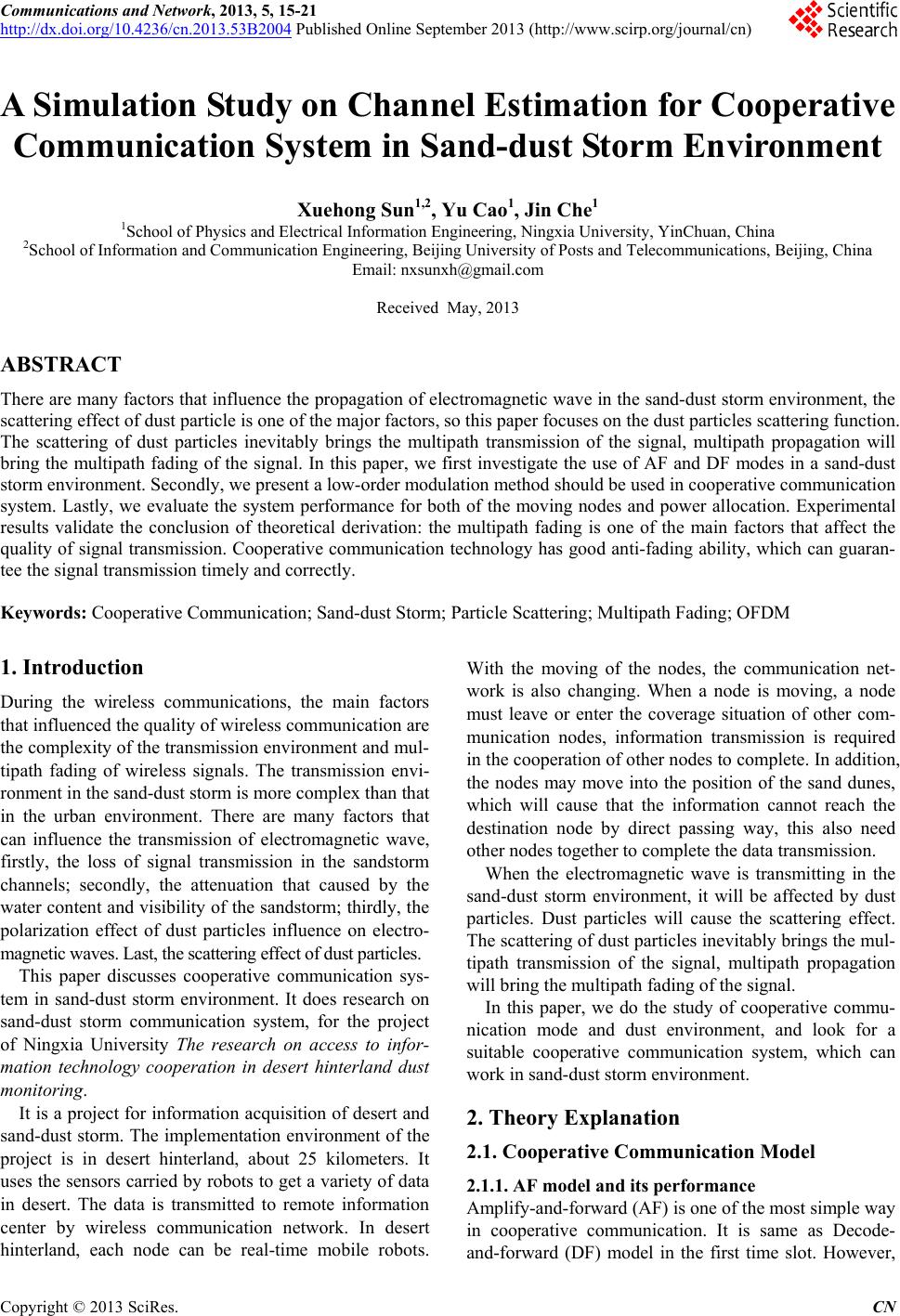 Communications and Network, 2013, 5, 15-21 http://dx.doi.org/10.4236/cn.2013.53B2004 Published Online September 2013 (http://www.scirp.org/journal/cn) A Simulation Study on Channel Estimation for Cooperative Communication System in Sand-dust Storm Environment Xuehong Sun1,2, Yu Cao1, Jin Che1 1School of Physics and Electrical Information Engineering, Ningxia University, YinChuan, China 2School of Information and Communication Engineering, Beijing University of Posts and Telecommunications, Beijing, China Email: nxsunxh@gmail.com Received May, 2013 ABSTRACT There are many factors that influence the propagation of electromagnetic wave in the sand-dust storm environment, the scattering effect of dust particle is one of the major factors, so this paper focuses on the dust particles scattering function. The scattering of dust particles inevitably brings the multipath transmission of the signal, multipath propagation will bring the multipath fading of the signal. In this paper, we first investigate the use of AF and DF modes in a sand-dust storm environment. Secondly, we present a low-order modulation method should be used in cooperative communication system. Lastly, we evaluate the system performance for both of the moving nodes and power allocation. Experimental results validate the conclusion of theoretical derivation: the multipath fading is one of the main factors that affect the quality of signal transmission. Cooperative communication technology has good anti-fading ability, which can guaran- tee the signal transmission timely and correctly. Keywords: Cooperative Communication; Sand-dus t Storm; Particle Scattering; Multipath Fading; OFDM 1. Introduction During the wireless communications, the main factors that influenced the quality of wireless commun ication are the complexity of the transmission environment and mul- tipath fading of wireless signals. The transmission envi- ronment in the sand-du s t storm is more complex than that in the urban environment. There are many factors that can influence the transmission of electromagnetic wave, firstly, the loss of signal transmission in the sandstorm channels; secondly, the attenuation that caused by the water content and visibility of the sandstorm; thirdly, the polarization effect of dust particles influence on electro- magnetic waves. Last, the scattering effect of dust particles. This paper discusses cooperative communication sys- tem in sand-dust storm environment. It does research on sand-dust storm communication system, for the project of Ningxia University The research on access to infor- mation technology cooperation in desert hinterland dust monitoring. It is a project for information acquisition of desert and sand-dust storm. The implementation environment of the project is in desert hinterland, about 25 kilometers. It uses the sensors carried by robots to get a variety of data in desert. The data is transmitted to remote information center by wireless communication network. In desert hinterland, each node can be real-time mobile robots. With the moving of the nodes, the communication net- work is also changing. When a node is moving, a node must leave or enter the coverage situation of other com- munication nodes, information transmission is required in the cooperation of other nodes to complete. In addition, the nodes may move into the position of the sand dunes, which will cause that the information cannot reach the destination node by direct passing way, this also need other nodes together to complete the data transmission. When the electromagnetic wave is transmitting in the sand-dust storm environment, it will be affected by dust particles. Dust particles will cause the scattering effect. The scattering of dust particles inevitably brings the mul- tipath transmission of the signal, multipath propagation will bring the multipath fading of th e signal. In this paper, we do the study of cooperative commu- nication mode and dust environment, and look for a suitable cooperative communication system, which can work in sand-dust storm environment. 2. Theory Explanation 2.1. Cooperative Communication Model 2.1.1. AF model and its performance Amplify-and-forward (AF) is one of the most simple way in cooperative communication. It is same as Decode- and-forward (DF) model in the first time slot. However, C opyright © 2013 SciRes. CN 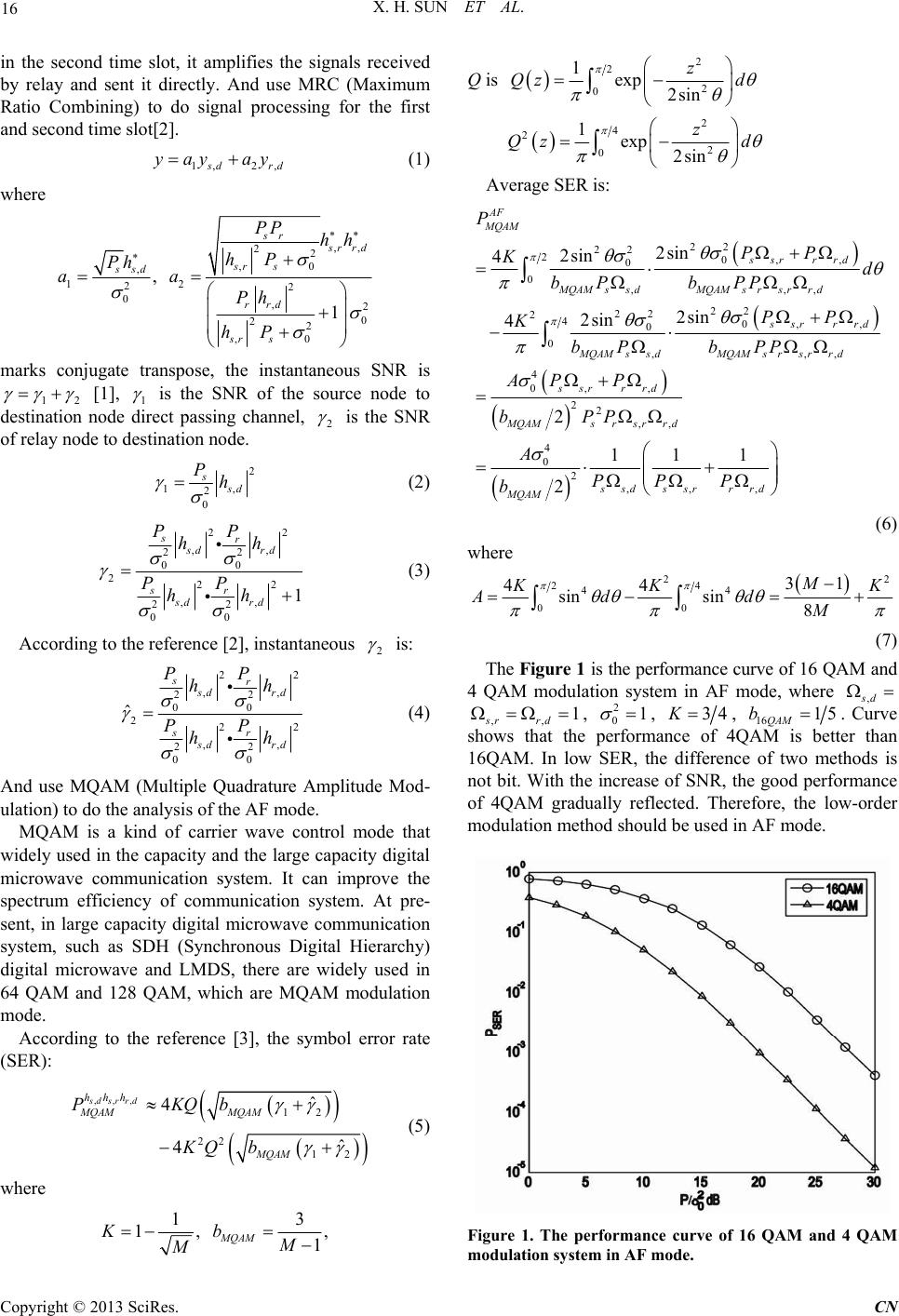 X. H. SUN ET AL. 16 in the second time slot, it amplifies the signals received by relay and sent it directly. And use MRC (Maximum Ratio Combining) to do signal processing for the first and second time slot[2 ]. 1, 2, s d yay ay rd (1) where ,, 22 ,0 , 12 22 0,2 0 22 ,0 , 1 sr s rrd sr s ssd rrd sr s PP hh hP Ph aa Ph hP marks conjugate transpose, the instantaneous SNR is 12 [1], 1 is the SNR of the source node to destination node direct passing channel, 2 is the SNR of relay node to destination node. 2 1 2 0 ssd Ph , (2) 22 ,, 22 00 222 ,, 22 00 1 sr sd rd sr sd rd PP hh PP hh (3) According to the reference [2], instan taneous 2 is: 22 ,, 22 00 222 ,, 22 00 ˆ sr sd rd sr sd rd PP hh PP hh (4) And use MQAM (Multiple Quadrature Amplitude Mod- ulation) to do the analysis of the AF mode. MQAM is a kind of carrier wave control mode that widely used in the cap acity and the large capacity digital microwave communication system. It can improve the spectrum efficiency of communication system. At pre- sent, in large capacity digital microwave communication system, such as SDH (Synchronous Digital Hierarchy) digital microwave and LMDS, there are widely used in 64 QAM and 128 QAM, which are MQAM modulation mode. According to the reference [3], the symbol error rate (SER): ,,,12 22 12 ˆ 4 ˆ 4 sd sr rd hhh MQAM MQAM MQAM PKQb KQ b (5) where 13 1, 1 MQAM Kb M M Q is 2 2 2 0 1exp 2sin z Qz d 2 4 22 0 1exp 2sin z Qz d Average SER is : 22 22 20, , 0 0,,, 22 22 240, , 0 0,, 4 0, , 22,, 4 02 2sin 2sin 4 2sin 2sin 4 2 1 2 AF MQAM ssr rrd MQAMssdMQAMsrsrr d ssr rrd MQAMssdMQAMsrsrr d ssr rrd MQAMsrsrr d MQAM P PP Kd bP bPP PP K bP bPP AP P bPP A b , ,, , 11 ssdssrrrd PP P (6) where 22 24 44 00 31 44 sinsin 8 M KK Ad d M K (7 The Figure 1 is the performance curve of 16 QAM 4 ) and QAM modulation system in AF mode, where ,sd ,, 1 sr rd , 2 01 , 34K, 1615 QAM b. Cur e pea4Qter than 16QAM. In low SER, the difference of two methods is not bit. With the increase of SNR, the good performance of 4QAM gradually reflected. Therefore, the low-order modulation method should be used in AF mode. ve shows that thrformnce of AM is bet , Figure 1. The performance curve of 16 QAM and 4 QAM modulation system in AF mode. Copyright © 2013 SciRes. CN 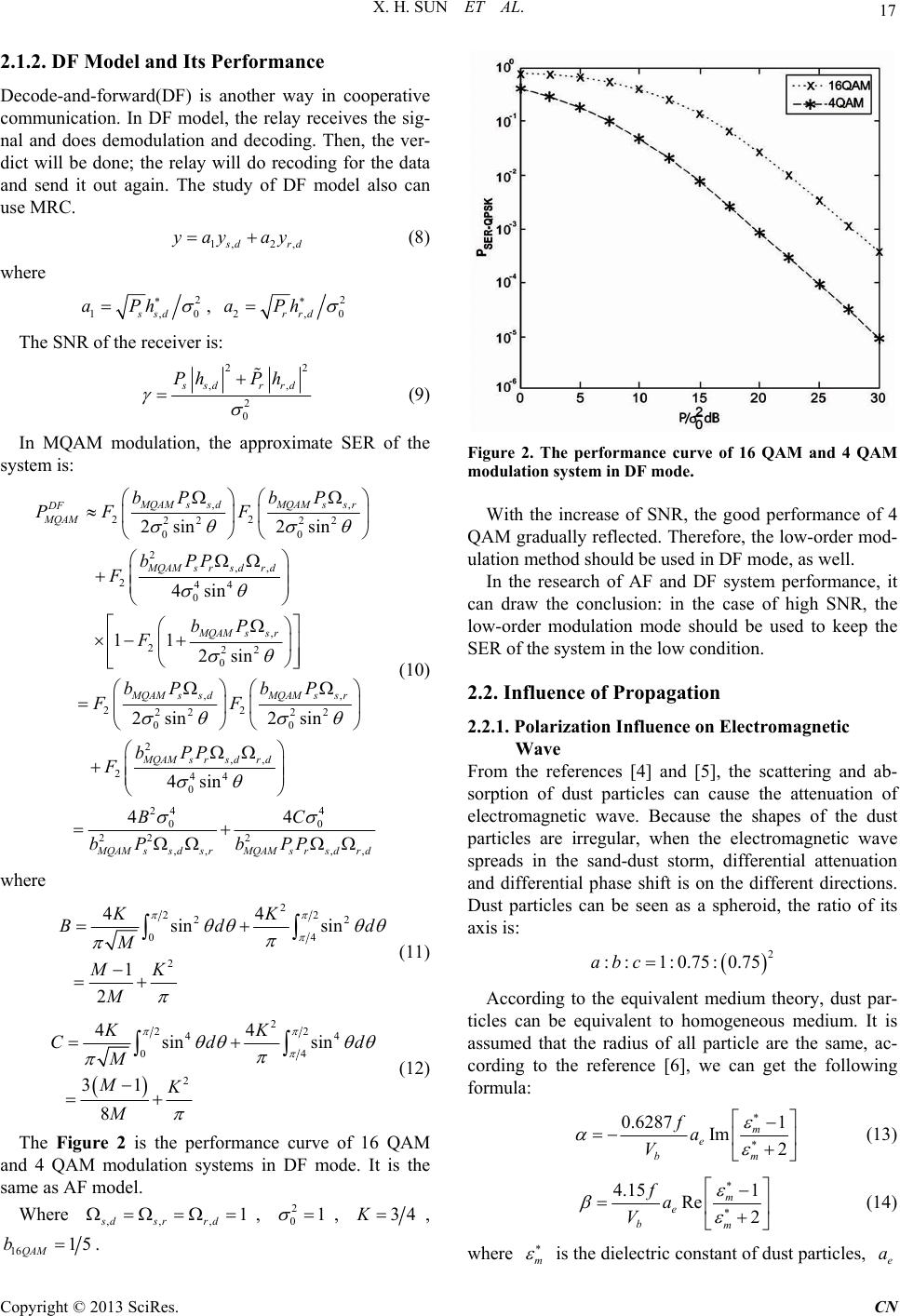 X. H. SUN ET AL. 17 2.1.2. DF Model and Its Performance Decode-and-forward(DF) is another way in cooperative communication. In DF model, the relay receives the sig- nal and does demodulation and decoding. Then, the ver- dict will be done; the relay will do recoding for the data and send it out again. The study of DF model also can use MRC. 1, 2, s dr yay ay d where (8) 2 1,0ssd aPh , 2 2,rrd aPh0 The SNR of the receiver is: 2 ,ssd Ph 2 , 2 0 rrd Ph (9) In MQAM modulation, the approxim system is: ate SER of the , 22 22 22 00 2,, 244 0 , 222 0 , 222 0 2sin 2sin 4sin 112sin 2sin MQAM ssdMQAM ssr, MQAMsrs drd MQAMssr MQAMss d FF bPP F bP F bP F DF MQAM bP bP P , 222 0 2,, 244 0 24 4 00 22 2 ,, ,, 2sin 4sin 44 MQAMssr MQAMsrsdr d M QAM ssdsrMQAM srsdrd bP F bPP F BC bP bPP (10) where 2 22 2 04 2 44 sin sin 1 2 KK Bd M MK M 2 d (11) 2 22 44 04 2 44 sin sin 31 8 KK Cd M MK M d (12) The Figure 2 is the performance curve of 16 QAM and 4 Qation systems in DF mode. It is the sa AM modul me as AF model. Where ,, 1 sd s , 21 , ,r rd034K , 16 15. QAM b Figure 2. The performance curve of 16 QAM and 4 QAM modulation system in DF mode. efore, the low-order mod- lation method should be used in DF mode, as well. the SE magnetic e scattering and ab- n of electroic wave. Because the shapes of the dust ding to the equivalent medium theory, dust par- ticles can be equivalent to homogeneou medium. It is assumed that the radius of all particle are the same, ac- co With the increase of SNR, the good performance of 4 QAM gradually reflected. Ther uIn the research of AF and DF system performance, it can draw the conclusion: in the case of high SNR, the low-order modulation mode should be used to keep R of the system in the low condition. 2.2. Influence of Propagation 2.2.1. Polarization Influence on Electro Wave From the references [4] and [5], th sorption of dust particles can cause the attenuatio magnet particles are irregular, when the electromagnetic wave spreads in the sand-dust storm, differential attenuation and differential phase shift is on the different directions. Dust particles can be seen as a spheroid, the ratio of its axis is: 2 ::1:0.75: 0.75abc Accor s rding to the reference [6], we can get the following formula: 1 0.6287 Im m e fa (13) 2 bm V 1 4.15 Re 2 m e bm fa V where (14) m is the dielectric constant of dust particles, e a Copyright © 2013 SciRes. CN 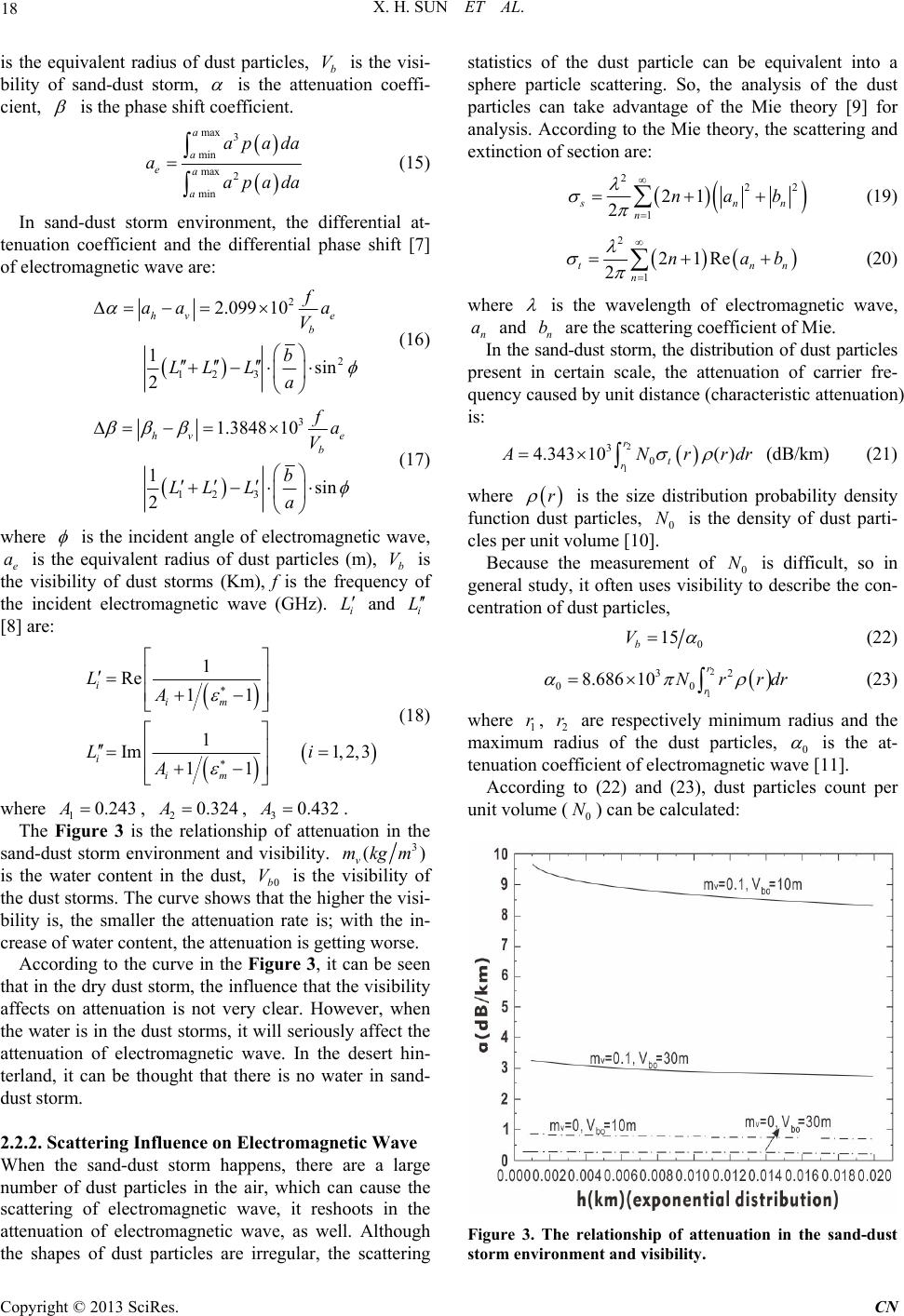 X. H. SUN ET AL. 18 is the equivalent radius of dust particles, is the visi- bility of sand-dust storm, b V is the at cient, tenuation coeffi- is the phase shift coefficient. max 3 min m2 min a a ea a apada aapada (15) ax on d are: In sa-dust storm envirment, the differential at- tenuation coefficient and the ifferentia of electromagnetic wave nd l phase shift [7] 2 2.099 10 1 hv e b aa a V LL 2 sin 12 3 2 f b La (16) 3 3 1.3848 10 1 2 hv e b La 12 LL sin b fa V (17) where the is the incident aof electromgnetic wave, is equivalent radi dust particles ( visibility of dust storm (Km), f is theequeof the incident electromagnetic wave (GHz). ngle us of s a fr L e a the m), b V is ncy and L i i [8] are: 1 Re 11 i im LA 1 im 0.324 the relationship ent and Im 2,3 11 i Li A (18) where The ion in the sand-dust storm environmvisibility. 1, 0.432 attenuat 1 A0.243, Figure 3 is 2 A, 3 A. of 3 ( v mkgm ) is the water content in the sibility of orms. Tcurve swhe r the visi- bi rse. at t particles ine air, whiccan cause the scattering of electromagnetic wave, it reshoots in the dust particles arg dust, ho th 0b V is the vi high h e irregular, the scatterin the dushe s that tet st the shapes of lity is, the smaller the attenuation rate is; with the in- crease of water content, the attenuation is get ting wo According to the curve in the Figure 3, it can be seen that in the dry dust storm, the influence that the visibility affects on attenuation is not very clear. However, when the water is in the dust storms, it will seriously affect the tenuation of electromagnetic wave. In the desert hin- terland, it can be thought that there is no water in sand- dust storm. 2.2.2. Sc a tt er ing Influence on Electromagnetic Wave When the sand-dust storm happens, there are a large number of dus attenuation of electromagnetic wave, as well. Although statistics of the dust particle can be equivalent into a sphere particle scattering. So, the analysis of the dust particles can take advantage of the Mie theory [9] for analysis. According to the Mie theory, the scattering and extinction of section are: 222 121 2 snn n nab (19) 2 121 2 t n Re nn nab (20) where b In the sand-d is the wavelength of electromag and are the scattering coefficient of Mie. ust storm, the distribution of dust particles present in certain scale, the attenuation o quency caused by unit distance (characteristic attenuation) netic wave, n an f carrier fre- is: r 2 1 30 4.34310( ) t r A Nrrdr (dB/km) (21) where r is the size distribution probability density function dust particles, N is the density of dust parti- cles 0 . pevolume [10] Because the measurement of general study, it often uses visibility to describe the con- on of r unit 0 N is difficult, so in centrati dust particles, 0 15 b V (22) 2 1 32 00 8.686 10r r Nrrdr (23) where 1 r, 2 r are respective ly minimum radius and the maximof the dust um radius particles, 0 is the at- agnetic wave [11]. tenuatioicient of electrom According to (22) and (23), dust parti unit volume ) can be calculated: n coeffcles count per (0 N Figure 3. The relationship of attenuation in the sand-dust storm environment and visibility. Copyright © 2013 SciRes. CN 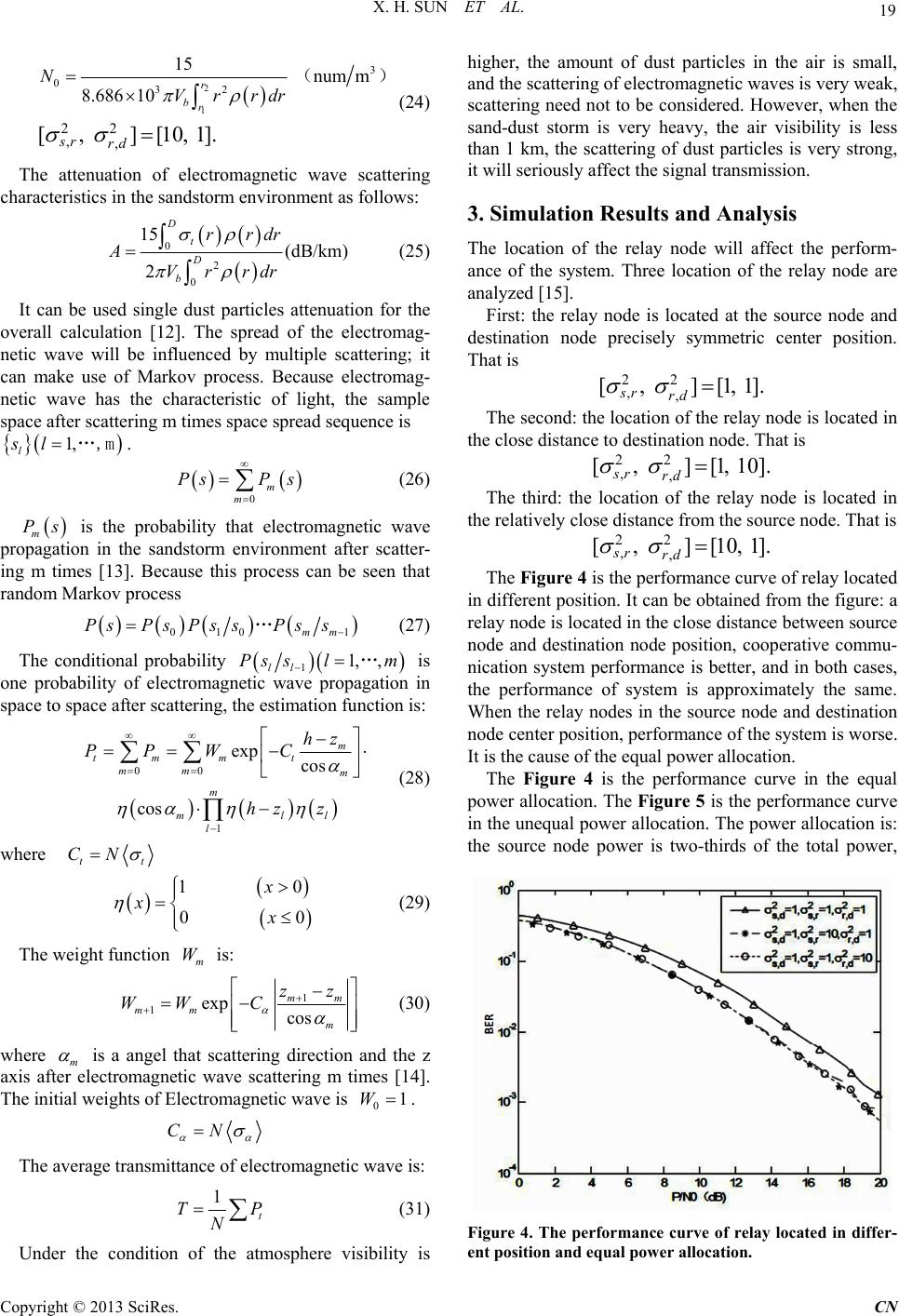 X. H. SUN ET AL. 19 2 1 3 032 22 ,, 15 num m 8.686 10 [, ][10, 1]. r br sr rd NVrrdr () (24) The attenuation of electromagnetic wave scattering characteristics in the sandstorm environment as follows: 0 2 0 15 (dB/km) 2 D t D b rrdr AVrrdr (25) It can be used single dust particles attenuation for the overall calculation [12]. The spread of the electromag- netic wave will be influenced by multiple scattering; it can make use of Markov process. Because electromag- netic wave has the characteristic of light, the sample space after scattering m times space spread sequence is (26) is the probability that electromagnetic propagation in the sandstorm environment after scatter- ing m times [13]. Because this process can be seen that ra 1, l sl…,m. 0m m PsPs m Ps wave ndom Markov process 0101mm PsPsPs sPss … (27) The conditional probability 11, , ll Ps slm … gnetic wave prop is one probability of electroma space to space after scattering, the estimation function is: agation in 00 1 exp cos cos m tm mt mm m m mll l hz PPWC hz z (28) where tt CN 10 0 x xx (29) 0 The weight function m W is: 1 1exp mm mm zz WW C cos m where (30) m is a angel that scattering direction ax scattering m times [1 and the z is after electromagnetic wave4]. The initial weights of Electromagnetic wave is 01W . CN The average transmittance of electromagnetic wave is: 1t TP N (31) Under the condition of the atmosphere visibility is higher, the amount of dust particles in the air is small, and the scattering of electromagnetic waves is very weak, scattering need not to be considered. However, w sand-dust storm is very heavy, the air visibility is less than 1 km, the scattering of dust particles is very strong, iously affecthe signal transmission. 3. Simulation Results and Analysis The location of the relay node will affect the perform- anee n of the relay node are anFirst: the relay node is located at the source nod destination node precisely symmetric center That is hen the it will sert ce of the system. Thrlocatio alyzed [15]. e and position. 22 ,, [, ][1, 1]. sr rd The seco nd: the location of the relay node is the close distance to destination node. That is located in . 22 ,, [, ][1,0] sr rd 1 The third: the location of the relay node is located in the relatively close distance from the source node. That is , 1]. 22 ,, [, ][10 sr rd The Figure 4 is the performance curve of relay located in different position. It can be obtained from the figure: a relay node is located in the close distance between source node and destination node position, cooperative commu- nication system performance is better, and in both cases, the performance of system is approximately the same. When the relay nodes in the source node and destination node center position, performance of the system is worse. It is the cause of the equal power allocation. The Figure 4 is the performance curve in the equal power allocation. The Figure 5 is the performance curve in the unequal power allocation. The power allocation is: the source node power is two-thirds of the total power, Figure 4. The performance curve of relay located in differ- ent position and equal power allocation. Copyright © 2013 SciRes. CN 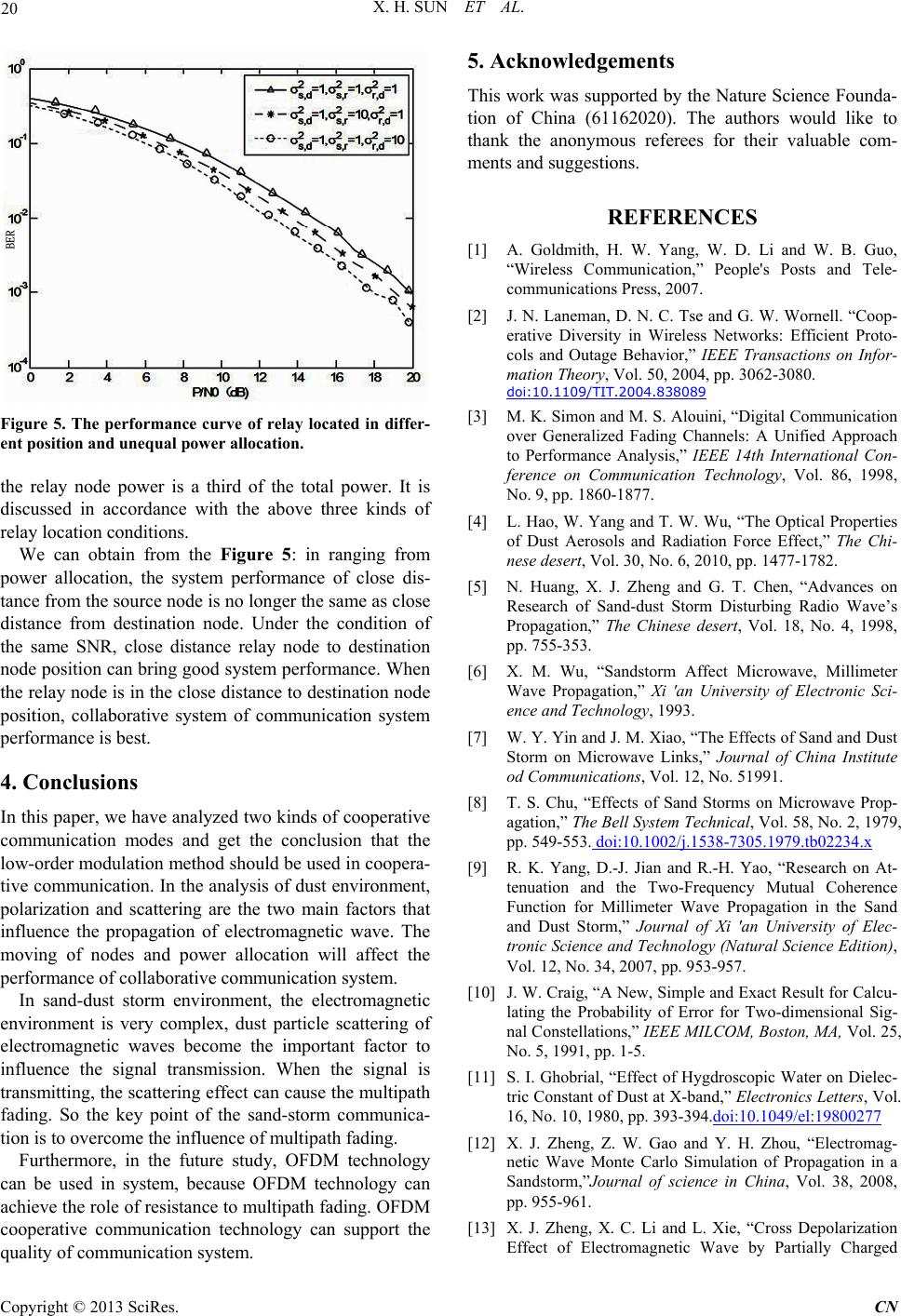 X. H. SUN ET AL. 20 Figure 5. The performance curve of relay located in differ- ent position and unequal power allocation. the relay node power is a third of the total power. It is discussed in accordance with the above three kinds of relay location conditions. We can obtain from the Figure 5: in ranging from he same as close distance from destination node. Under the condition of the same SNR, close distance relay node to destination node position can bring good system performance. When the relay node is in the close distance to destination node position, collaborative system of communication system performance is best. 4. Conclusions In this paper, we have analyzed two kinds of cooperative communication modes and get the conclusion that the low-order modulation method should be used in coopera- tive communication. In the analysis of dust environm polarization and scattering are the two main factors t influence the propagation of electromagnetic wave. The moving of nodes and power allocation will affect the lectromagnetic nvironment is very complex, dust particle scattering of ultipath fa rted by the Nature Science Found a- 62020). The authors would like to rees for their valuable com- power allocation, the system performance of close dis- tance from the source node is no longer t ent, hat performance of collaborative communication system. In sand-dust storm environment, the e e electromagnetic waves become the important factor to influence the signal transmission. When the signal is transmitting, the scattering effect can cause the m ding. So the key point of the sand-storm communica- tion is to overcome the influence of multipath fading. Furthermore, in the future study, OFDM technology can be used in system, because OFDM technology can achieve the role of resistance to multipath fading. OFDM cooperative communication technology can support the quality of communication system. 5. Acknowledgements This work was suppo tion of China (611 thank the anonymous refe ments and suggestions. REFERENCES [1] A. Goldmith, H. W. Yang, W. D. Li and W. B. Guo, “Wireless Communication,” People's Posts and Tele- communications Press, 2007. [2] J. N. Laneman, D. N. C. Tse and G. W. Wornell. “Coop- erative Diversity in Wireless Networks: Efficient Proto- cols and Outage Behavior,” IEEE Transactions on Infor- mation Theory, Vol. 50, 2004, pp. 3062-3080. doi:10.1109/TIT.2004.838089 [3] M. K. Simon and M. S. Alouini, “Digital Communication over Generalized Fading Channels: A Unified Approach to Performance Analysis,” IEEE 14th International Con- ference on Communication Technology, Vol. 86, 1998, No. 9, pp. 1860-1877. isturbing Radio Wave’s e desert, Vol. 18, No. 4, 1998, Links,” Journal of China Institute od Communications, Vol. 12, No. 51991. [8] T. S. Chu, “E Microwave Prop- [4] L. Hao, W. Yang and T. W. Wu, “The Opt ical Properties of Dust Aerosols and Radiation Force Effect,” The Chi- nese desert, Vol. 30, No. 6, 2010, pp. 1477-1782. [5] N. Huang, X. J. Zheng and G. T. Chen, “Advances on Research of Sand-dust Storm D Propagation,” The Chines pp. 755-353. [6] X. M. Wu, “Sandstorm Affect Microwave, Millimeter Wave Propagation,” Xi 'an University of Electronic Sci- ence and Technology, 1993. [7] W. Y. Yin and J. M. Xiao, “The Effects of Sand and Dust Storm on Microwave ffects of Sand Storms on agation,” The Bell System Technical, Vol. 58, No. 2, 1979, pp. 549-553. doi:10.1002/j.1538-7305.1979.tb02234.x [9] R. K. Yang, D.-J. Jian and R.-H. Yao, “Research on At- of Hygdroscopic Water on Dielec- tenuation and the Two-Frequency Mutual Coherence Function for Millimeter Wave Propagation in the Sand and Dust Storm,” Journal of Xi 'an University of Elec- tronic Science and Technology (Natural Science Edition), Vol. 12, No. 34, 2007, pp. 953-957. [10] J. W. Craig, “A New, Simple and Exact Result for Calcu- lating the Probability of Error for Two-dimensional Sig- nal Constellations,” IEEE MILCOM, Boston, MA, Vol. 25, No. 5, 1991, pp. 1-5. [11] S. I. Ghobrial, “Effect tric Constant of Dust at X-band,” Electronics Letters, Vol. 16, No. 10, 1980, pp. 393-394.doi:10.1049/el:19800277 [12] X. J. Zheng, Z. W. Gao and Y. H. Zhou, “Electromag- . C. Li and L. Xie, “Cross Depolarization netic Wave Monte Carlo Simulation of Propagation in a Sandstorm,”Journal of science in China, Vol. 38, 2008, pp. 955-961. [13] X. J. Zheng, X Effect of Electromagnetic Wave by Partially Charged Copyright © 2013 SciRes. CN 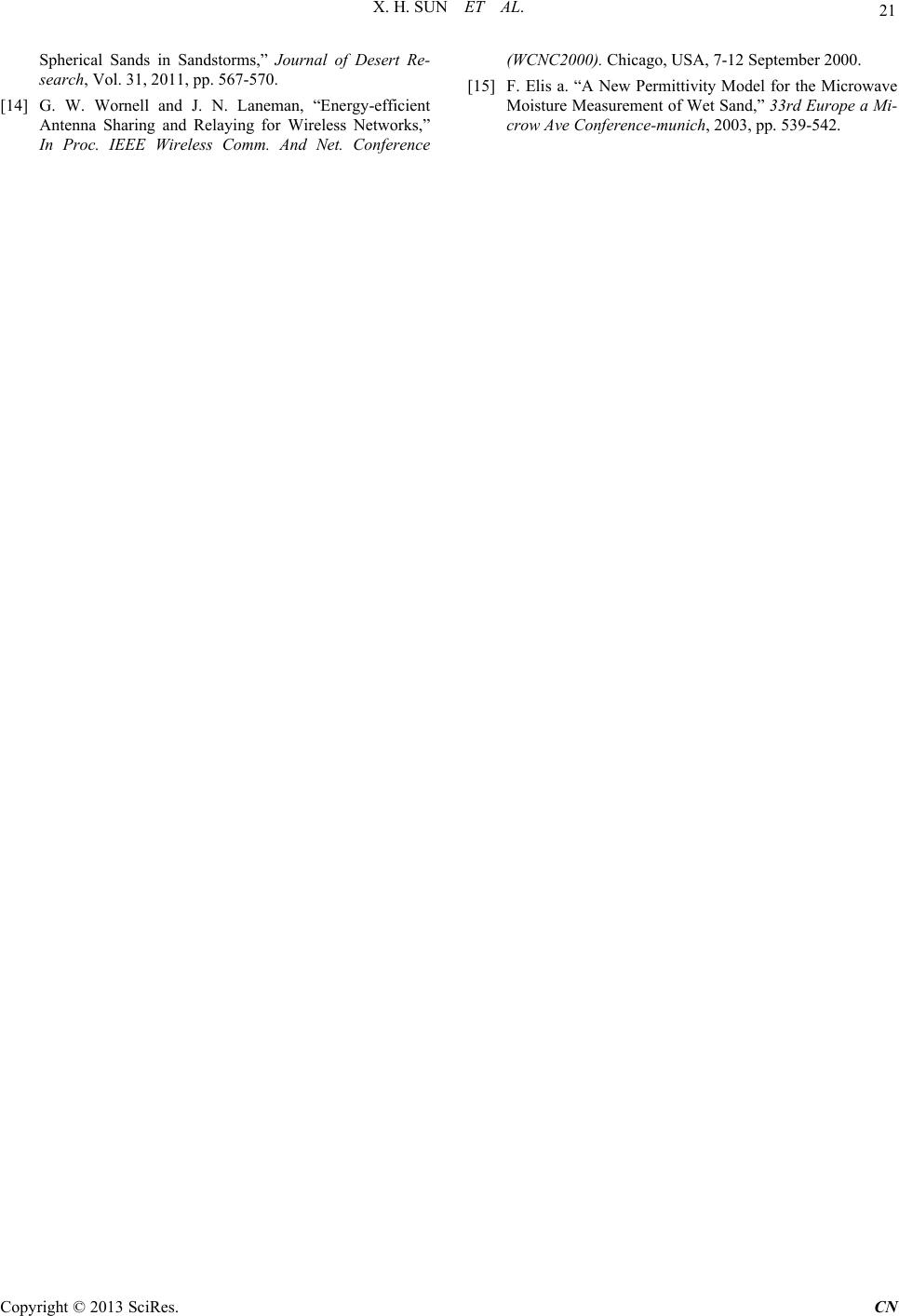 X. H. SUN ET AL. Copyright © 2013 SciRes. CN 21 -570. et. Conference - Spherical Sands in Sandstorms,” Journal of Desert Re- search, Vol. 31, 2011, pp. 567 [14] G. W. Wornell and J. N. Laneman, “Energy-efficient Antenna Sharing and Relaying for Wireless Networks,” In Proc. IEEE Wireless Comm. And N (WCNC2000). Chicago, USA, 7-12 September 2000. [15] F. Elis a. “A New Permittivity Model for the Microwave Moisture Measurement of Wet Sand,” 33rd Europe a Mi crow Ave Conference-munich, 2003, pp. 539-542. |

